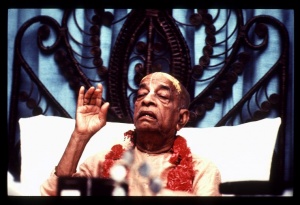CC Madhya 19.187

A.C. Bhaktivedanta Swami Prabhupada
TEXT 187
- hāsya, adbhuta, vīra, karuṇa, raudra, bībhatsa, bhaya
- pañca-vidha-bhakte gauṇa sapta-rasa haya
SYNONYMS
hāsya — laughter; adbhuta — wonder; vīra — chivalry; karuṇa — pathetic feeling; raudra — anger; bībhatsa — disaster; bhaya — fearfulness; pañca-vidha-bhakte — in five kinds of devotees; gauṇa — indirect; sapta-rasa — seven kinds of mellows; haya — there are.
TRANSLATION
“In addition to the five direct mellows, there are seven indirect mellows, known as laughter, wonder, chivalry, compassion, anger, disaster and fear.
PURPORT
Hāsya, adbhuta, vīra, karuṇa, raudra, bhaya and bībhatsa—the seven indirect mellows—are explained in the Bhakti-rasāmṛta-sindhu (4.1.6). The hāsya-bhakti-rasa, laughing devotion, is explained as follows:
- vakṣyamāṇair vibhāvādyaiḥ puṣṭiṁ hāsa-ratir gatā
- hāsya-bhakti-raso nāma budhair eṣa nigadyate
“When through devotional service a laughing attachment to Kṛṣṇa is developed, it is called hāsya-bhakti-rasa by learned scholars.”
Similarly, adbhuta-rasa is described in the Bhakti-rasāmṛta-sindhu (4.2.1):
- ātmocitair vibhāvādyaiḥ svādyatvaṁ bhakta-cetasi
- sā vismaya-ratir nītādbhuta-bhakti-raso bhavet
“When one’s general attachment is fixed in wonder, it is called adbhuta-bhakti-rasa.”
Vīra-bhakti-rasa is described as follows (Bhakti-rasāmṛta-sindhu 4.3.1):
- saivotsāha-ratiḥ sthāyī vibhāvādyair nijocitaḥ
- ānīyamānā svādyatvaṁ vīra-bhakti-raso bhavet
- yuddha-dāna-dayā-dharmaiś caturdhā-vīra ucyate
“When attachment to Kṛṣṇa mixes with the bellicose tendency, the charitable tendency or the merciful tendency in the heart of the devotee, such devotion is called vīra-bhakti-rasa.”
Karuṇa-bhakti-rasa is described as follows (Bhakti-rasāmṛta-sindhu 4.4.1):
- ātmocitair vibhāvādyair nītā puṣṭiṁ satāṁ hṛdi
- bhavec choka-ratir bhakti-raso hi karuṇābhidhaḥ
“When one’s devotional attitude and attachment for Kṛṣṇa is mixed with lamentation, it is called karuṇa-bhakti-rasa.”
Similarly, raudra-bhakti-rasa is described as follows (Bhakti-rasāmṛta-sindhu 4.5.1):
- nītā krodha-ratiḥ puṣṭiṁ vibhāvādyair nijocitaiḥ
- hṛdi bhakta-janasyāsau raudra-bhakti-raso bhavet
“When devotion is mixed with anger in the heart of the devotee, the taste is called raudra-bhakti-rasa.”
Bhayānaka-bhakti-rasa is described as follows (Bhakti-rasāmṛta-sindhu 4.6.1):
- vakṣyamāṇair vibhāvādyaiḥ puṣṭiṁ bhaya-ratir gatā
- bhayānakābhidho bhakti-raso dhīrair udīryate
- “When devotion is mixed with fear, it is called bhayānaka-bhakti-rasa.”
Bībhatsa-bhakti-rasa is described as follows (Bhakti-rasāmṛta-sindhu 4.7.1):
- puṣṭiṁ nija-vibhāvādyair jugupsā-ratir āgatā
- asau bhakti-raso dhīrair bībhatsākhya itīryate
“When one’s attachment for Kṛṣṇa develops in an abominable way, and the devotee enjoys it, that is called bībhatsa-bhakti-rasa.”
In conclusion, when a pure devotee is situated in any of the five principal mellows (śānta, dāsya, sakhya, vātsalya or madhura) and that mellow is mixed with one or more of the seven indirect bhakti-rasas (hāsya, adbhuta, vīra, karuṇa, raudra, bhayānaka or bībhatsa), the indirect mellows become prominent.